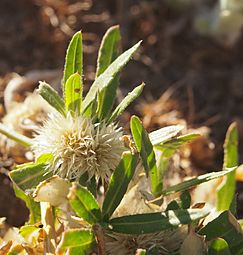Alternanthera nodiflora facts for kids
Quick facts for kids Alternanthera nodiflora |
|
|---|---|
 |
|
| Scientific classification | |
| Genus: |
Alternanthera
|
| Species: |
nodiflora
|
| Synonyms | |
|
Alternanthera nodiflora var. linearifolia Moq. |
|
Alternanthera nodiflora, also known as common joyweed, is a type of flowering plant. It belongs to the Amaranthaceae family. This plant is originally from Australia, where it grows in all the main states. You can also find it in Tasmania, many parts of Africa, Japan, and Myanmar.
What Does Common Joyweed Look Like?
Alternanthera nodiflora is a plant that grows upright and lives for about one year. Its branches are mostly smooth. However, the parts where leaves or branches grow out (called nodes) are covered with thick, tangled hairs. You can also see two lines of hairs along the branches.
The leaves of this plant are also mostly smooth. They are long and narrow, usually between 2 and 8 centimeters (about 1 to 3 inches) in length. Their edges are smooth and not toothed. The flowers grow in round clusters, often grouped together. The fruit of the plant is quite small.
How Was Common Joyweed Named?
This plant was first officially described in 1810 by a botanist named Robert Brown. He was a famous Scottish botanist.
The scientific name nodiflora tells us something special about the plant. It comes from two Latin words:
- Nodus, which means "knot" or "node".
- Flos or floris, which means "flower".
So, nodiflora means "flowers at the nodes" or "flowers arranged like knots". This describes how the flowers grow in tight, round clusters at the nodes of the plant.
Gallery




